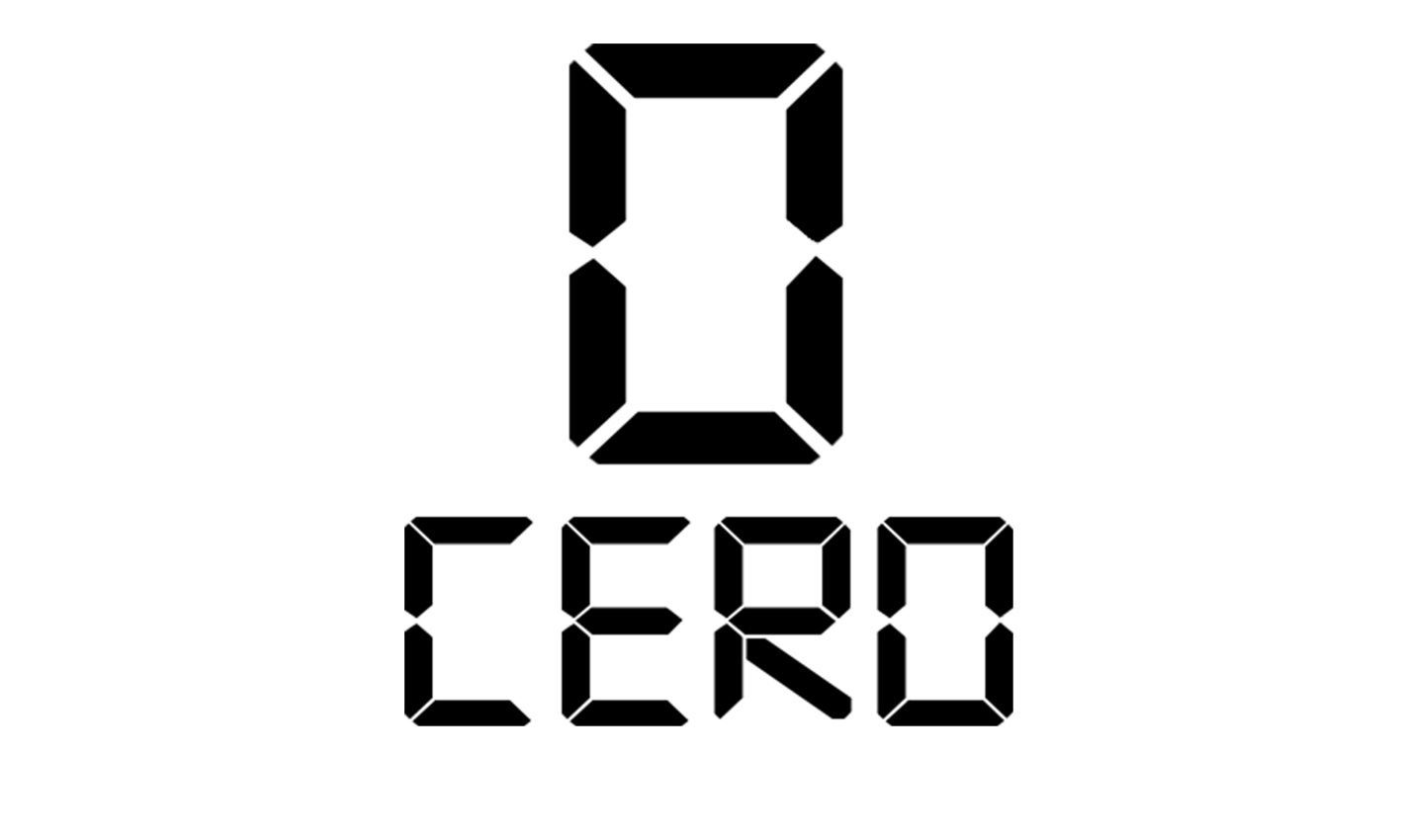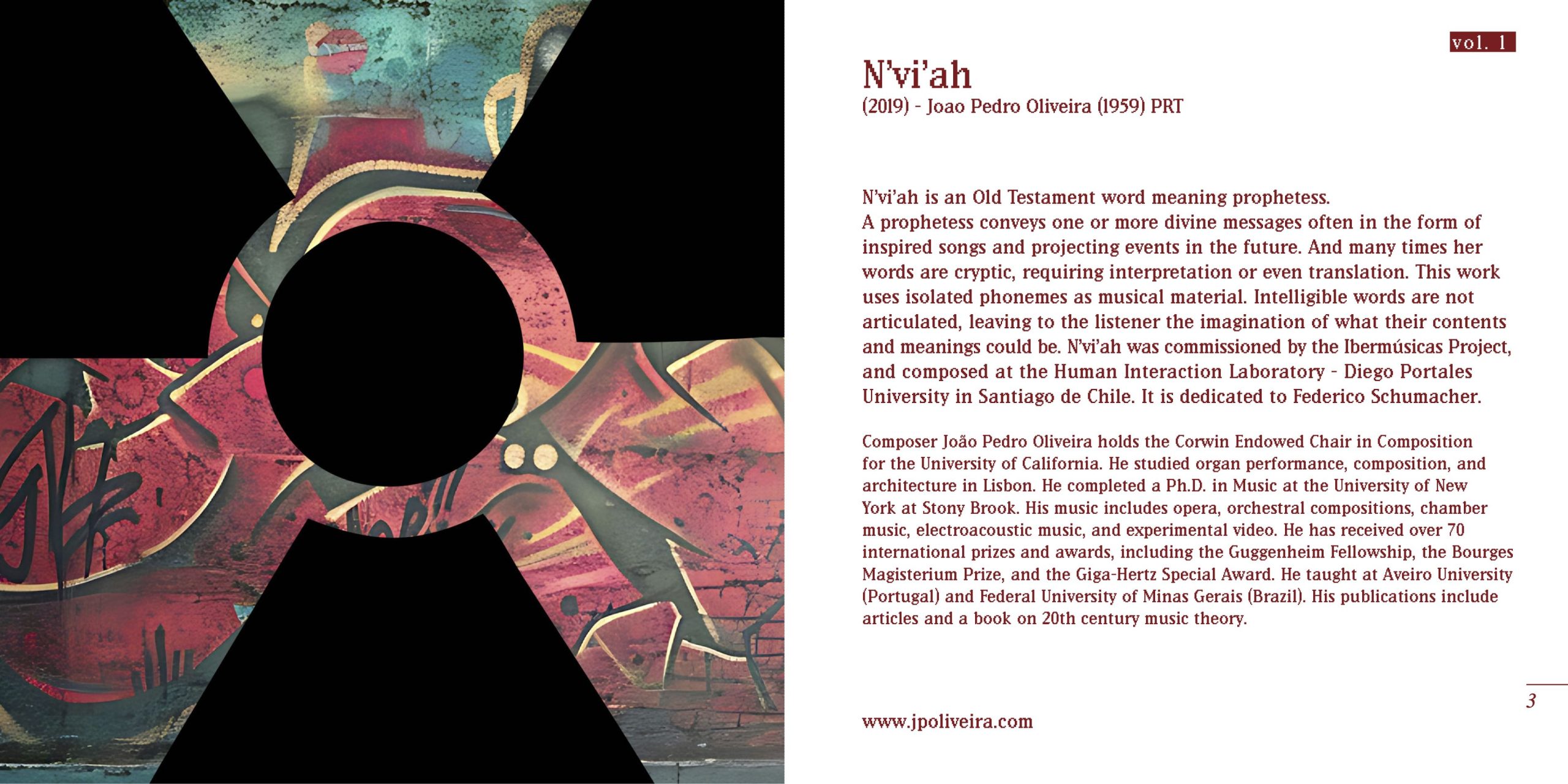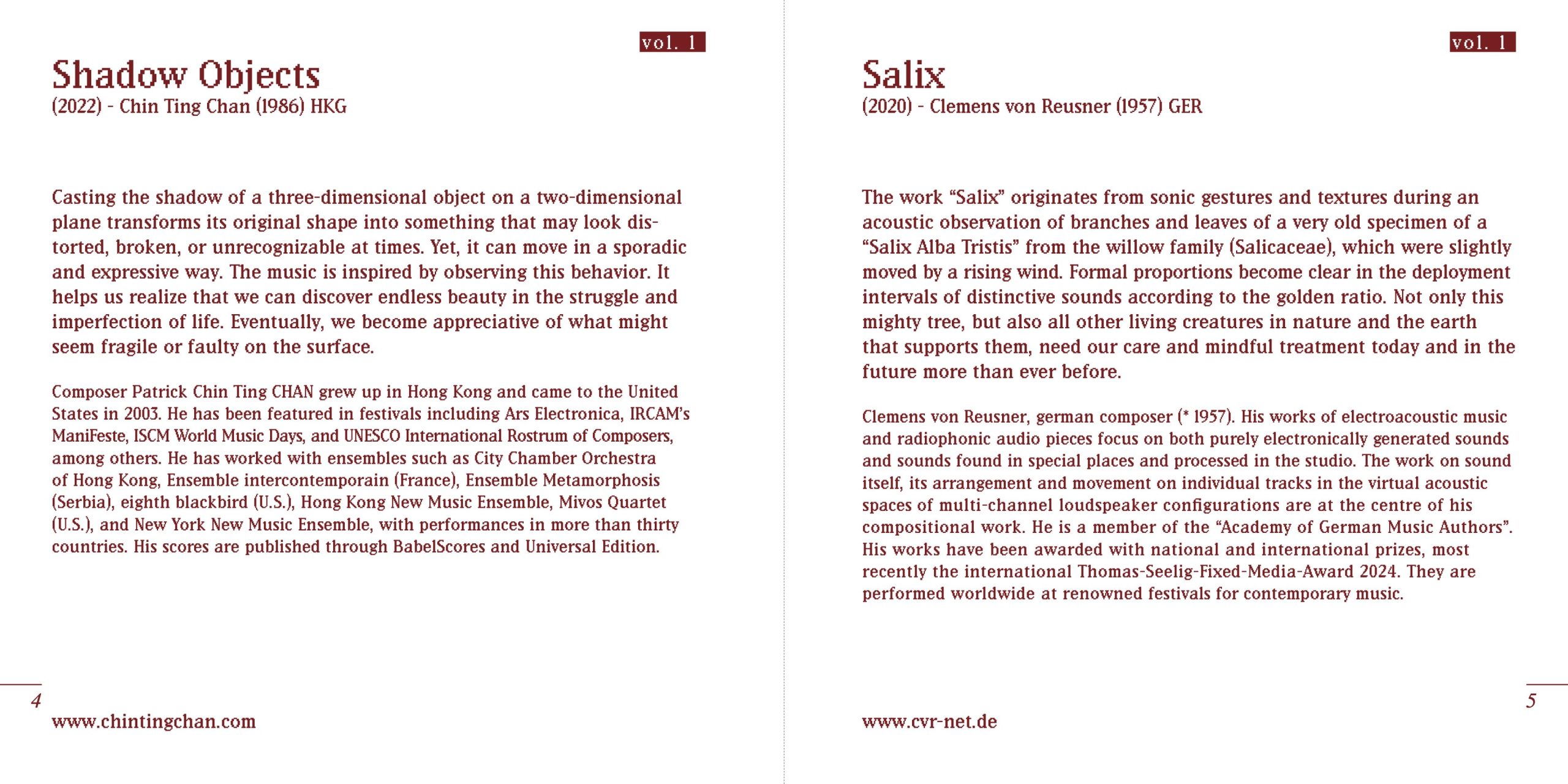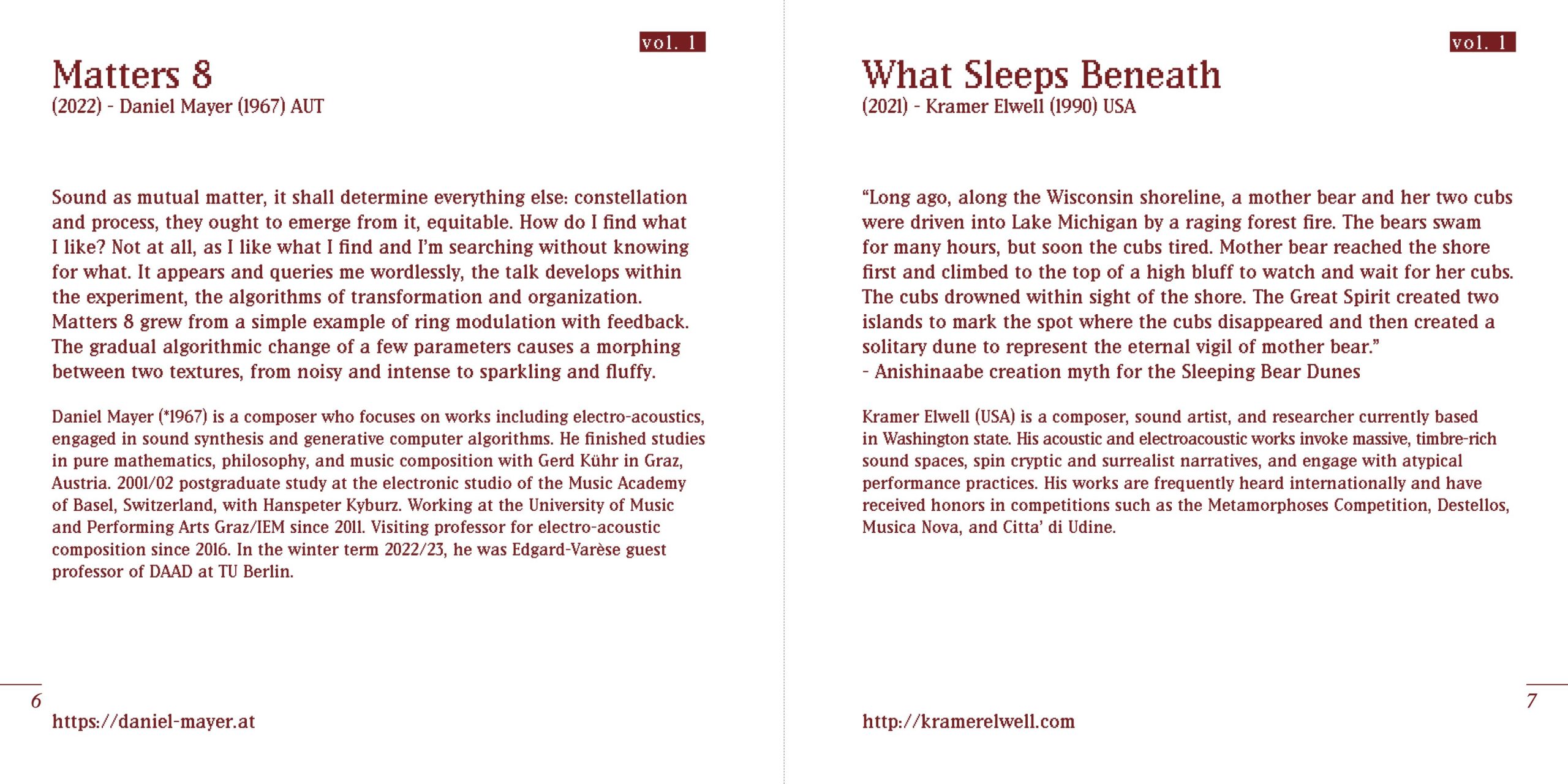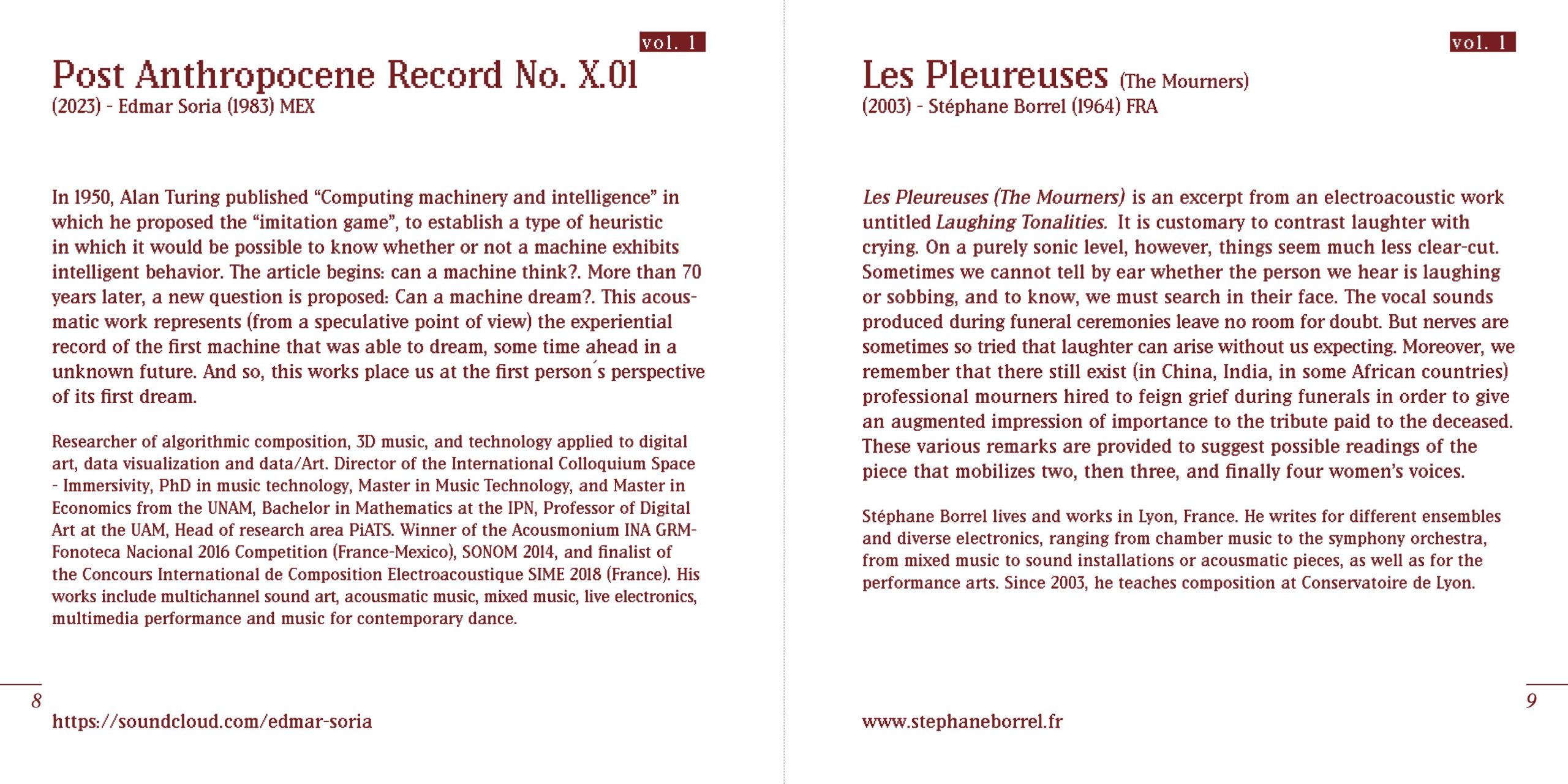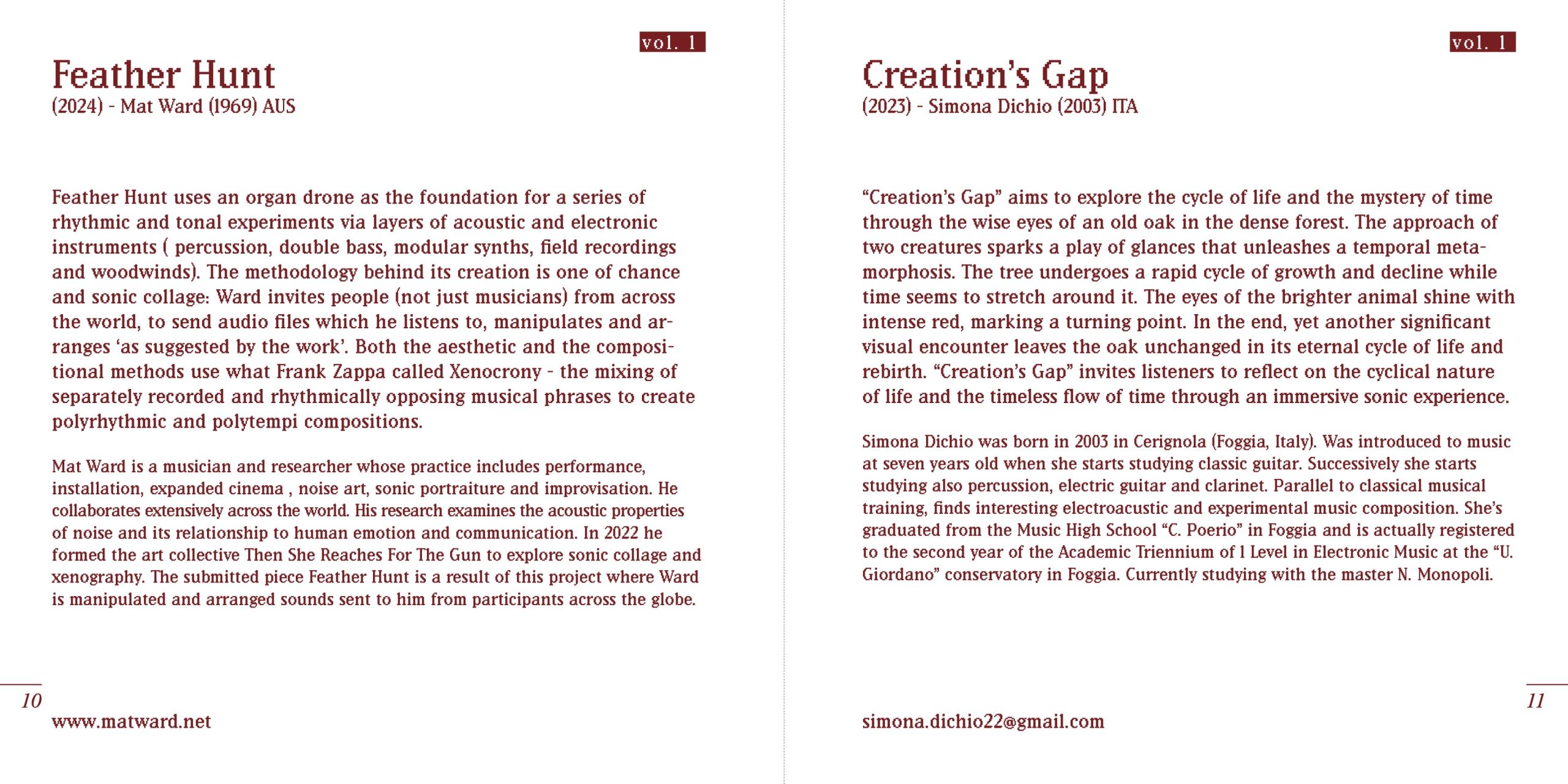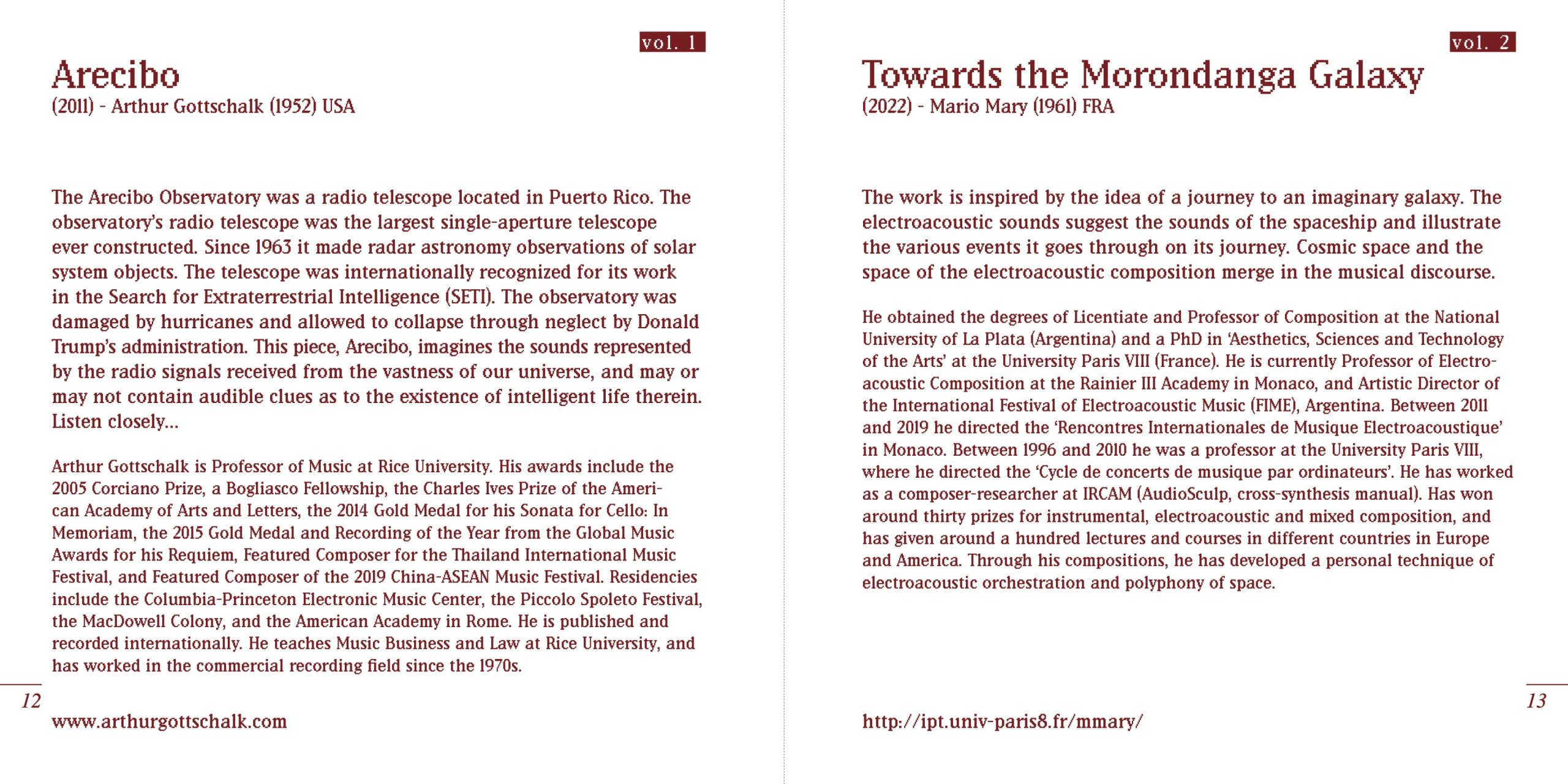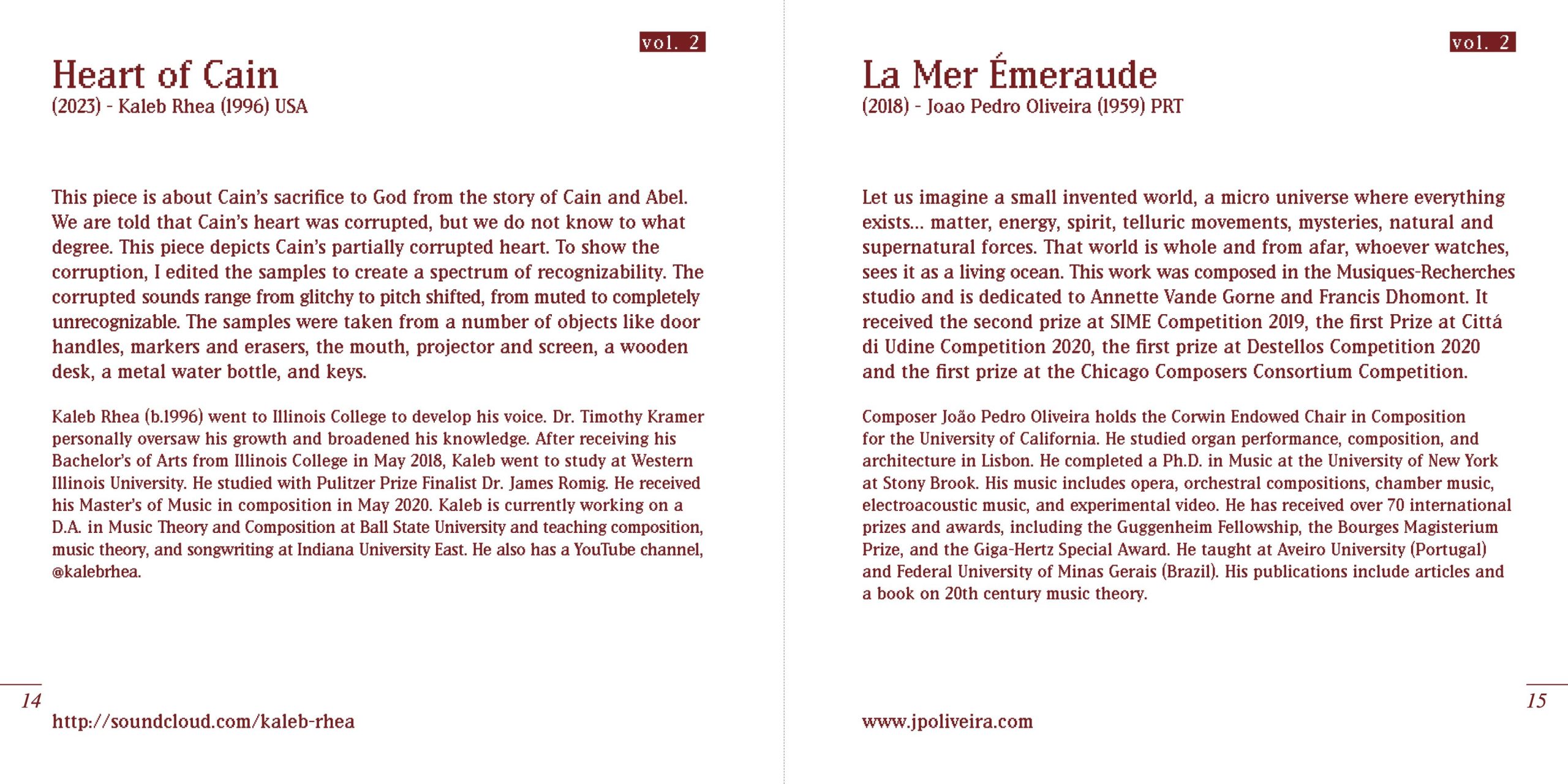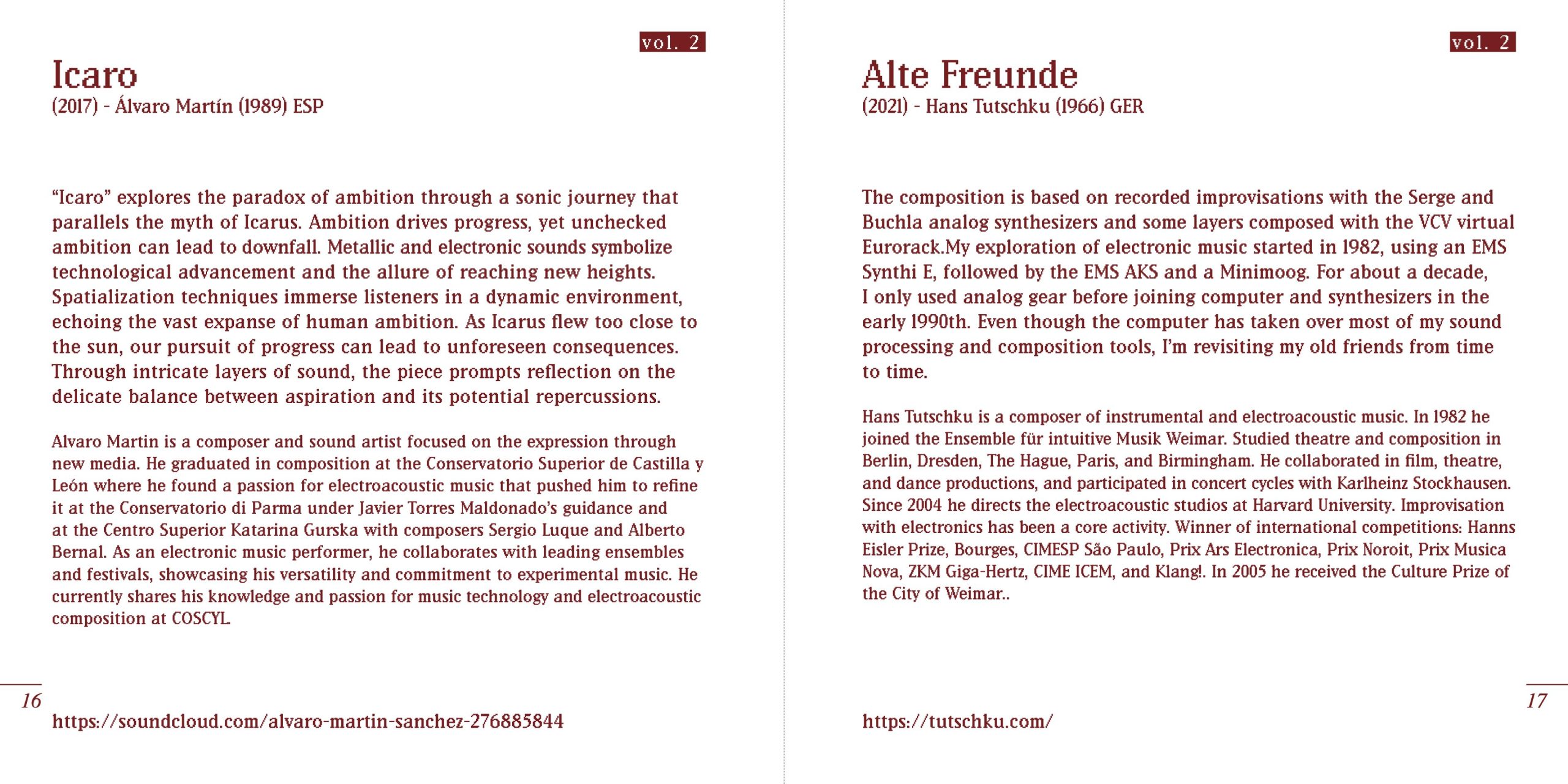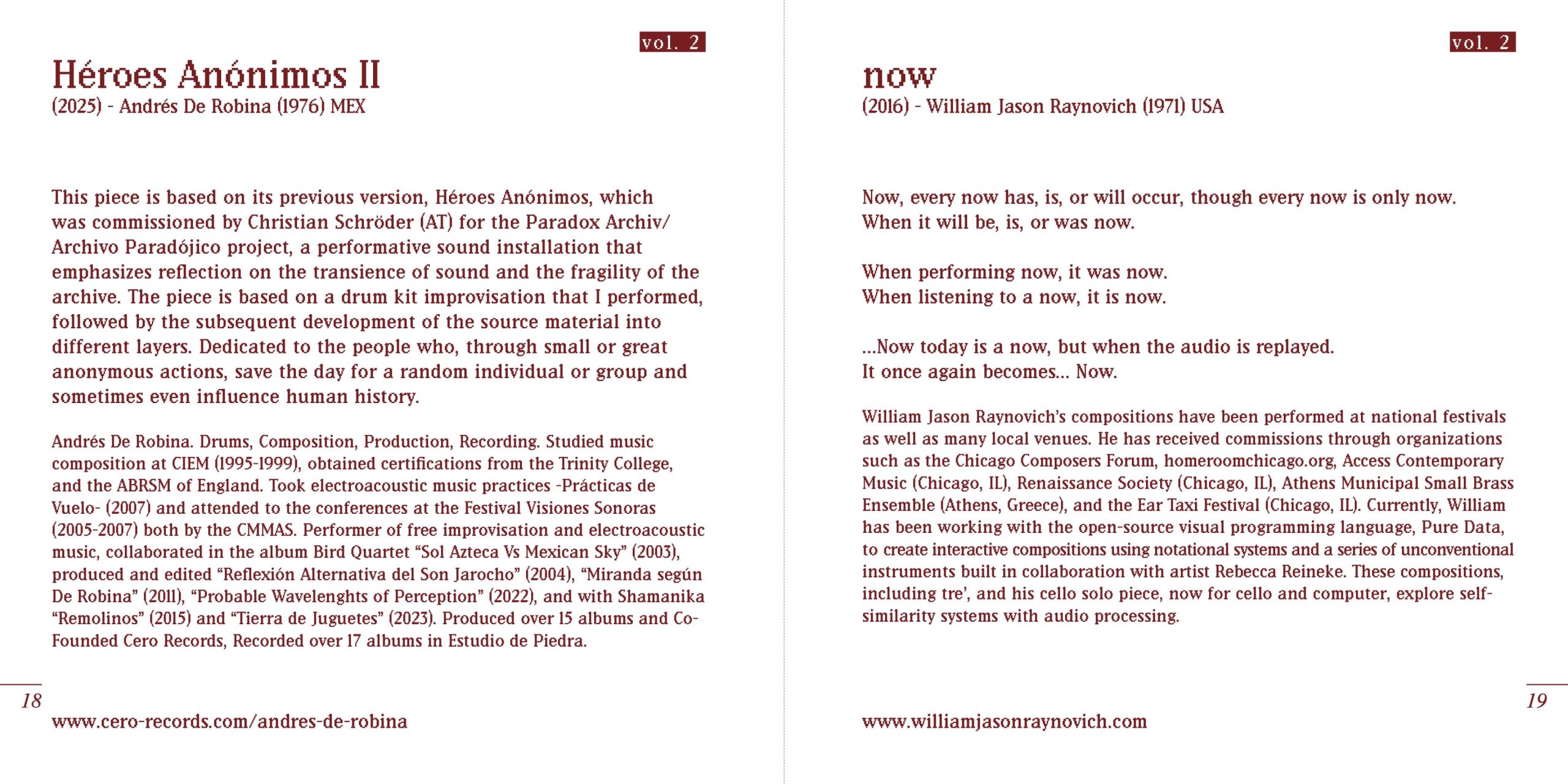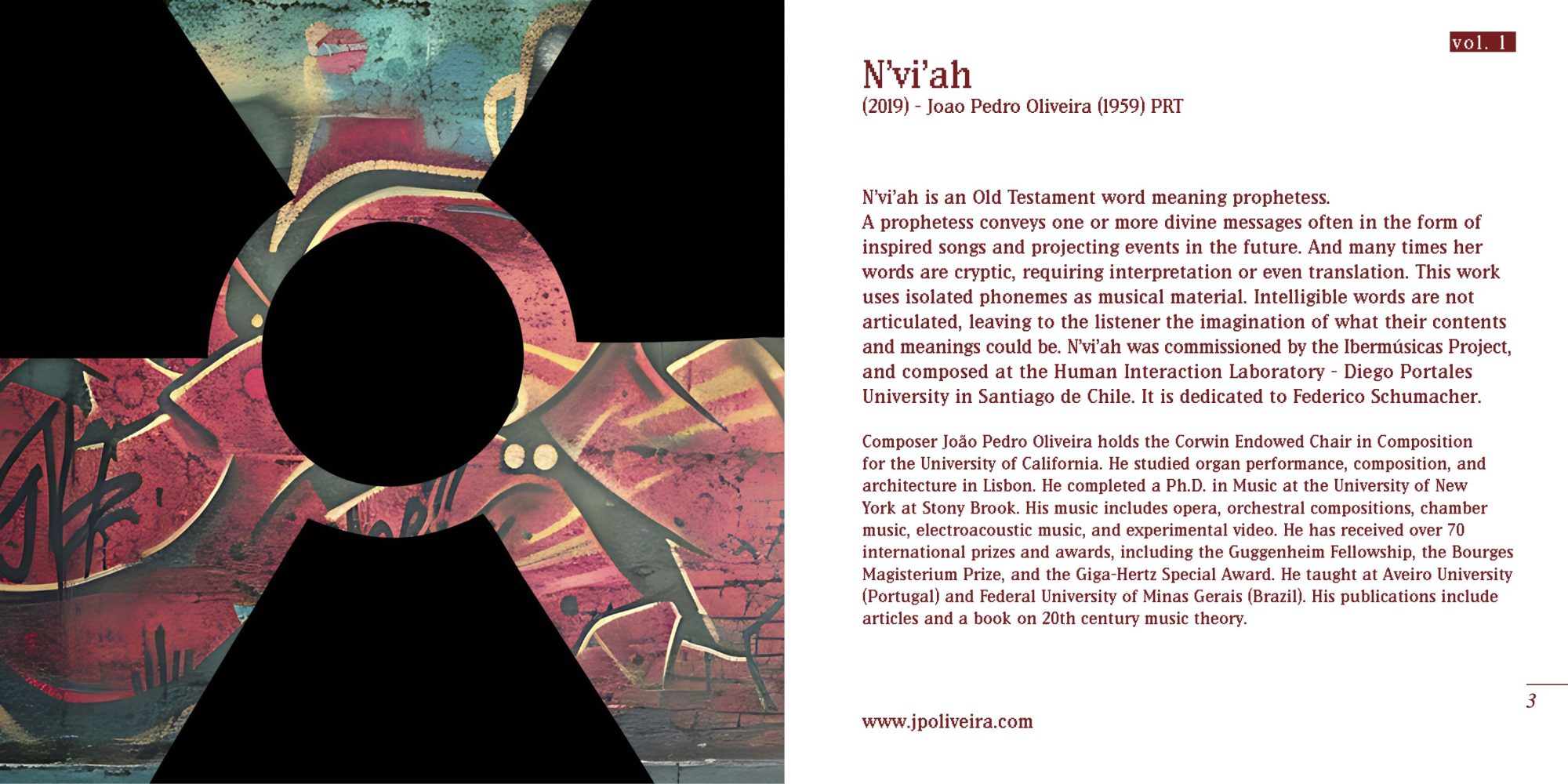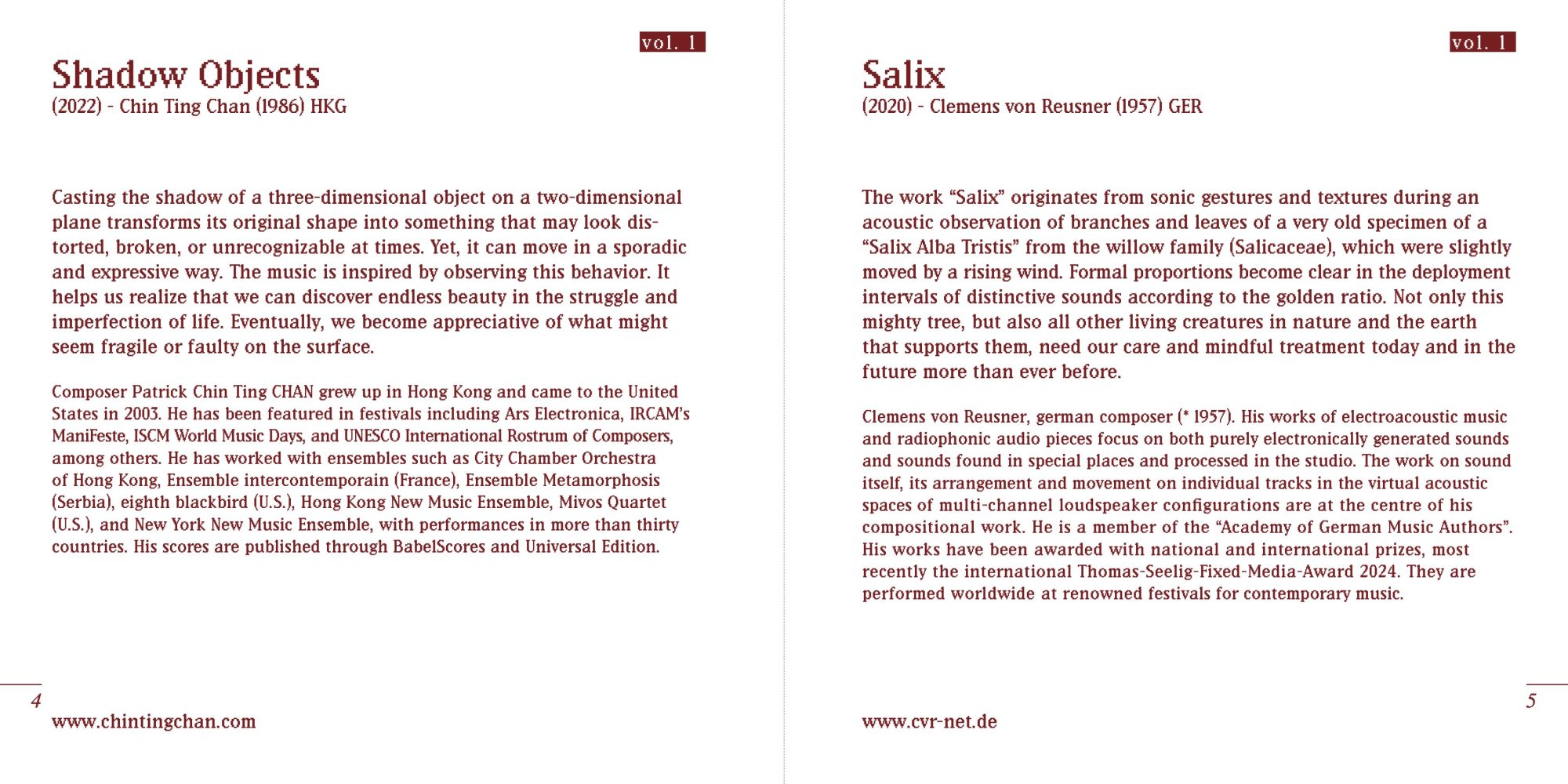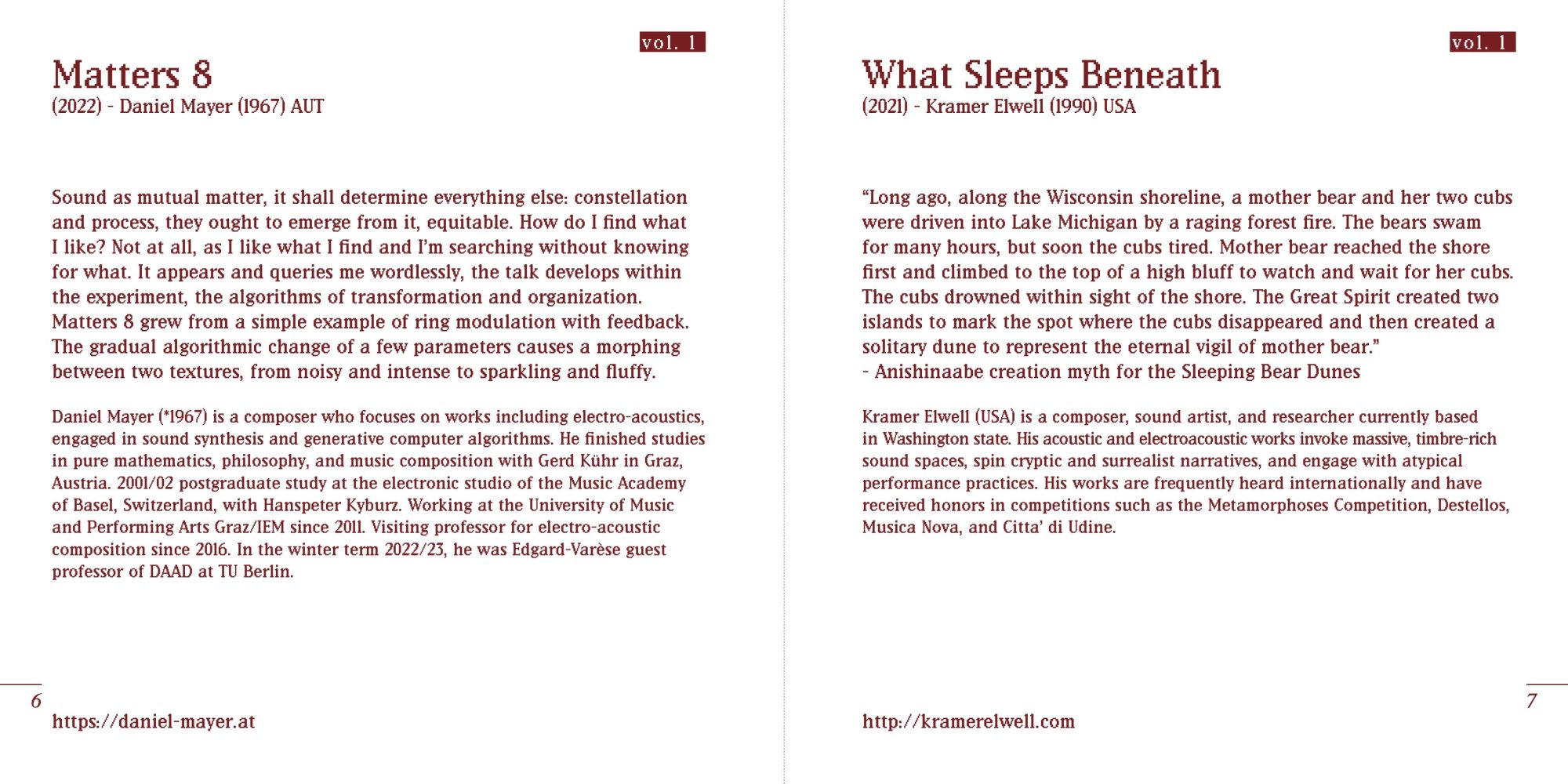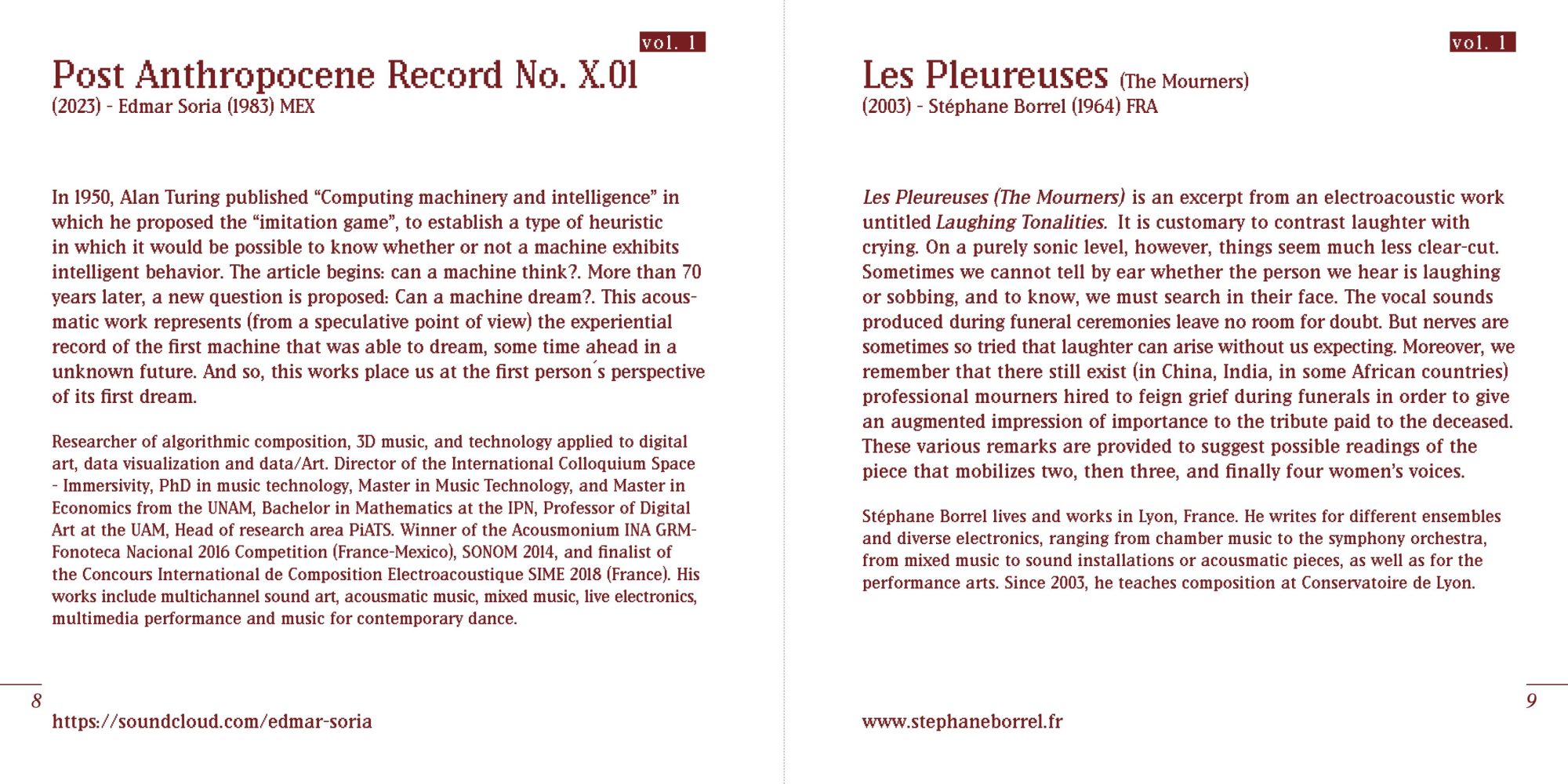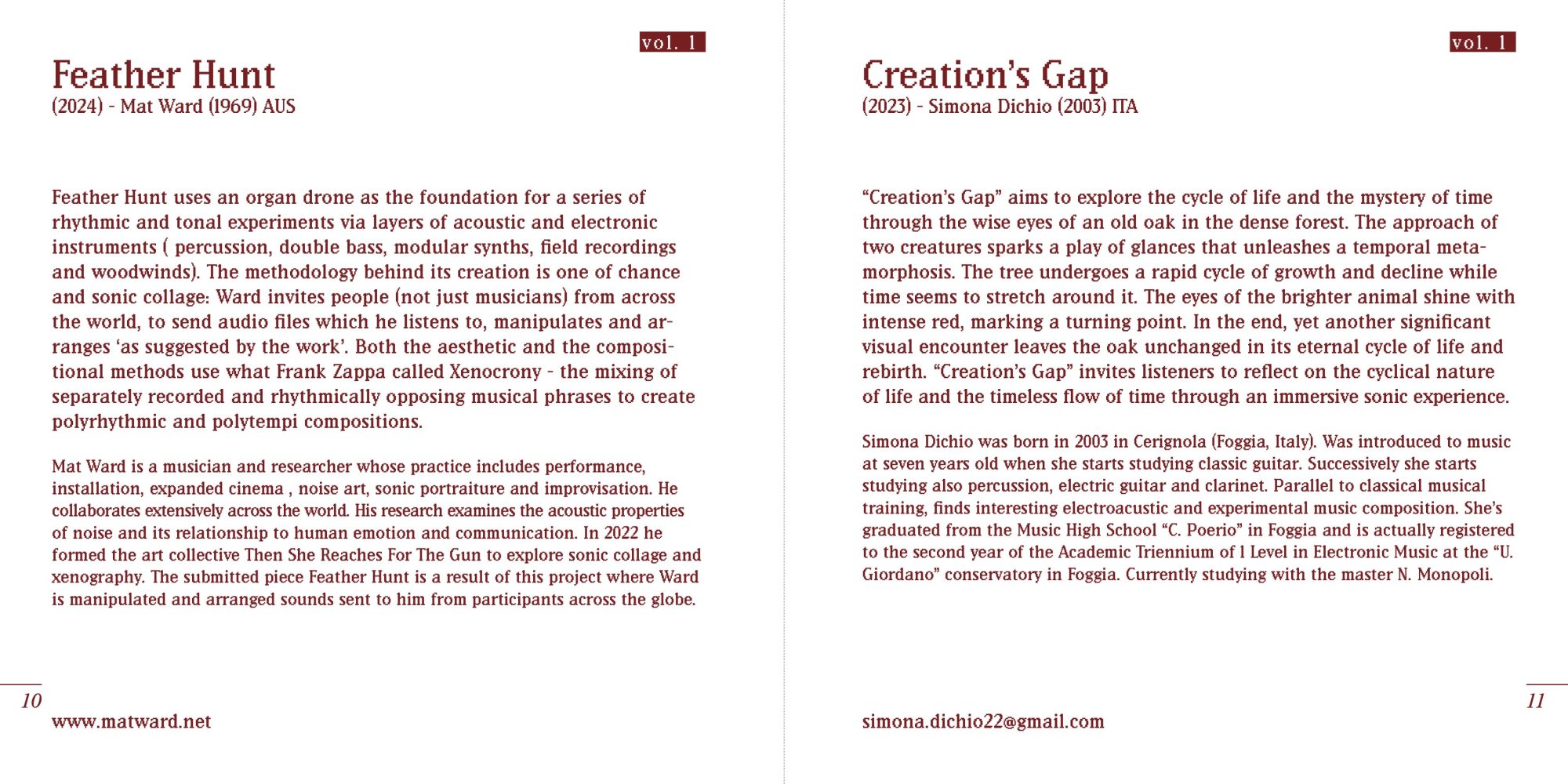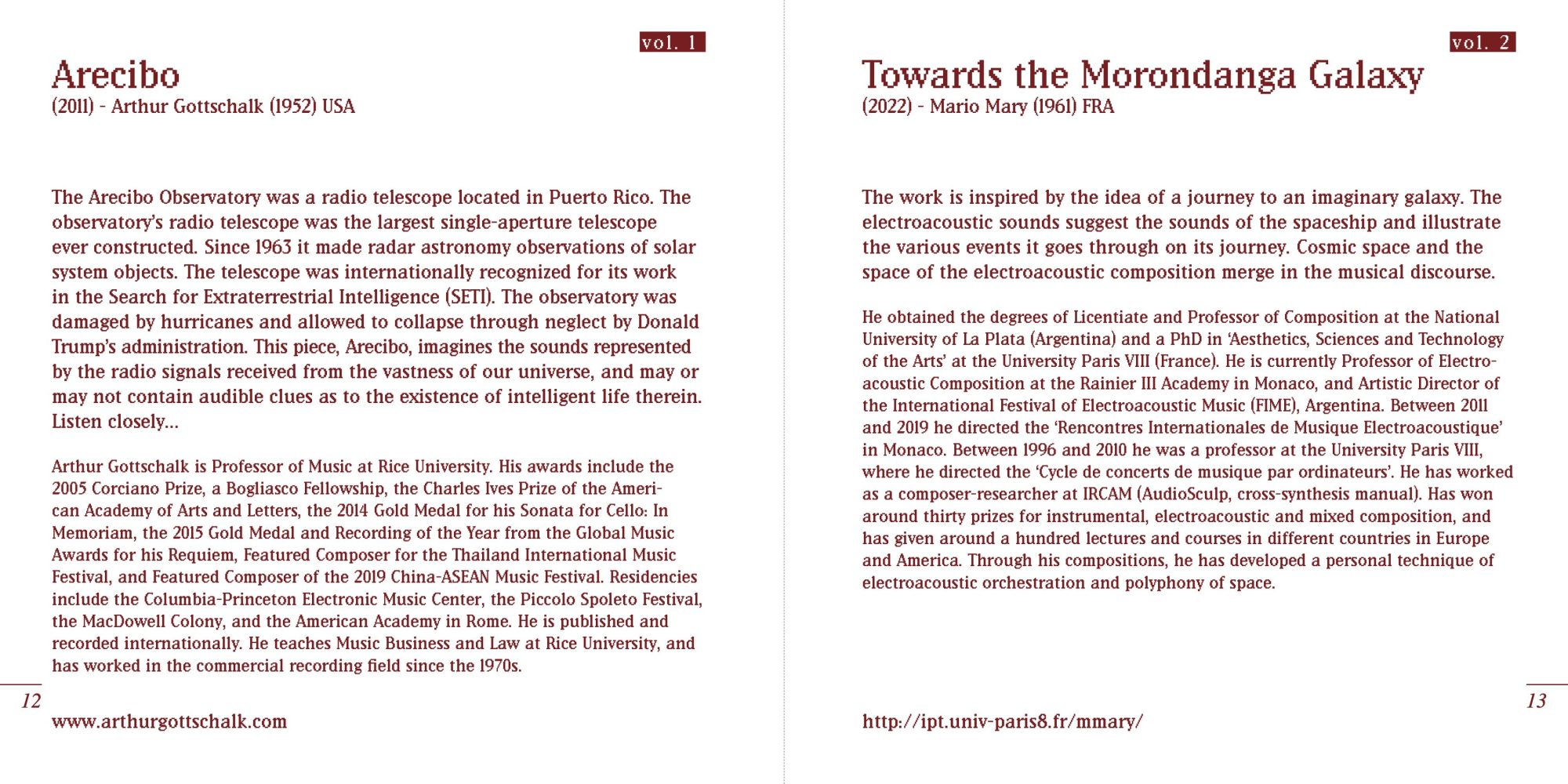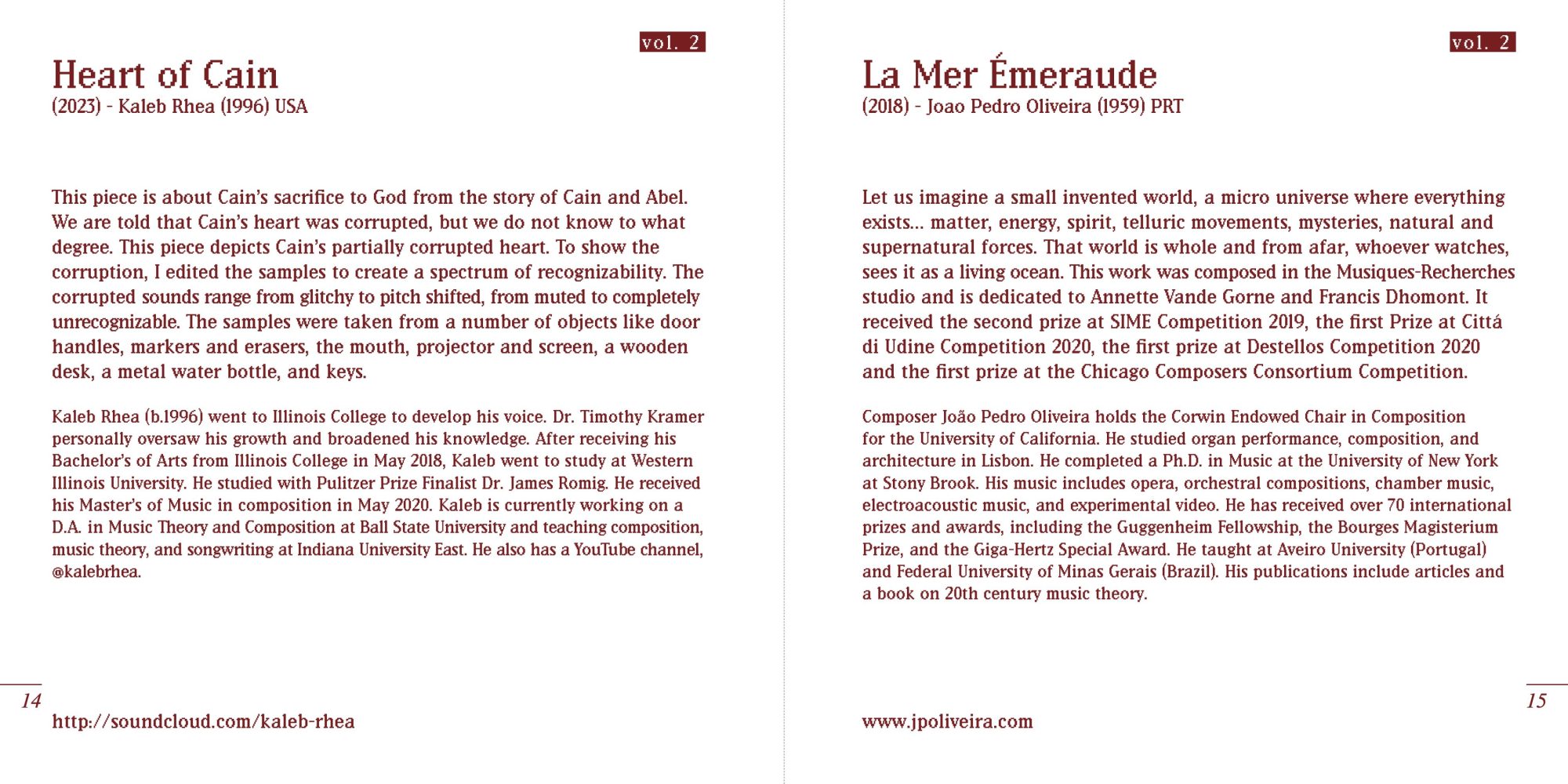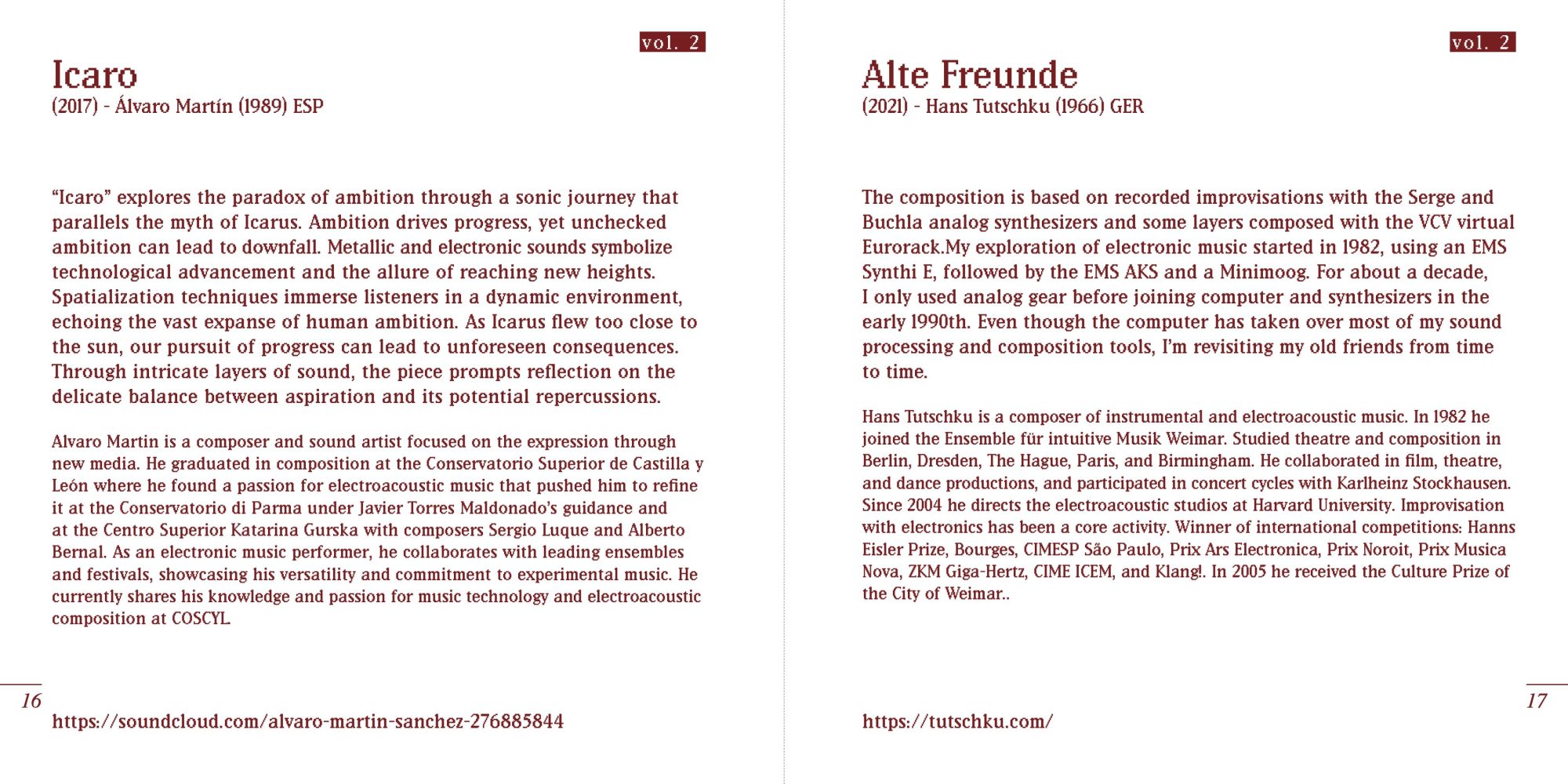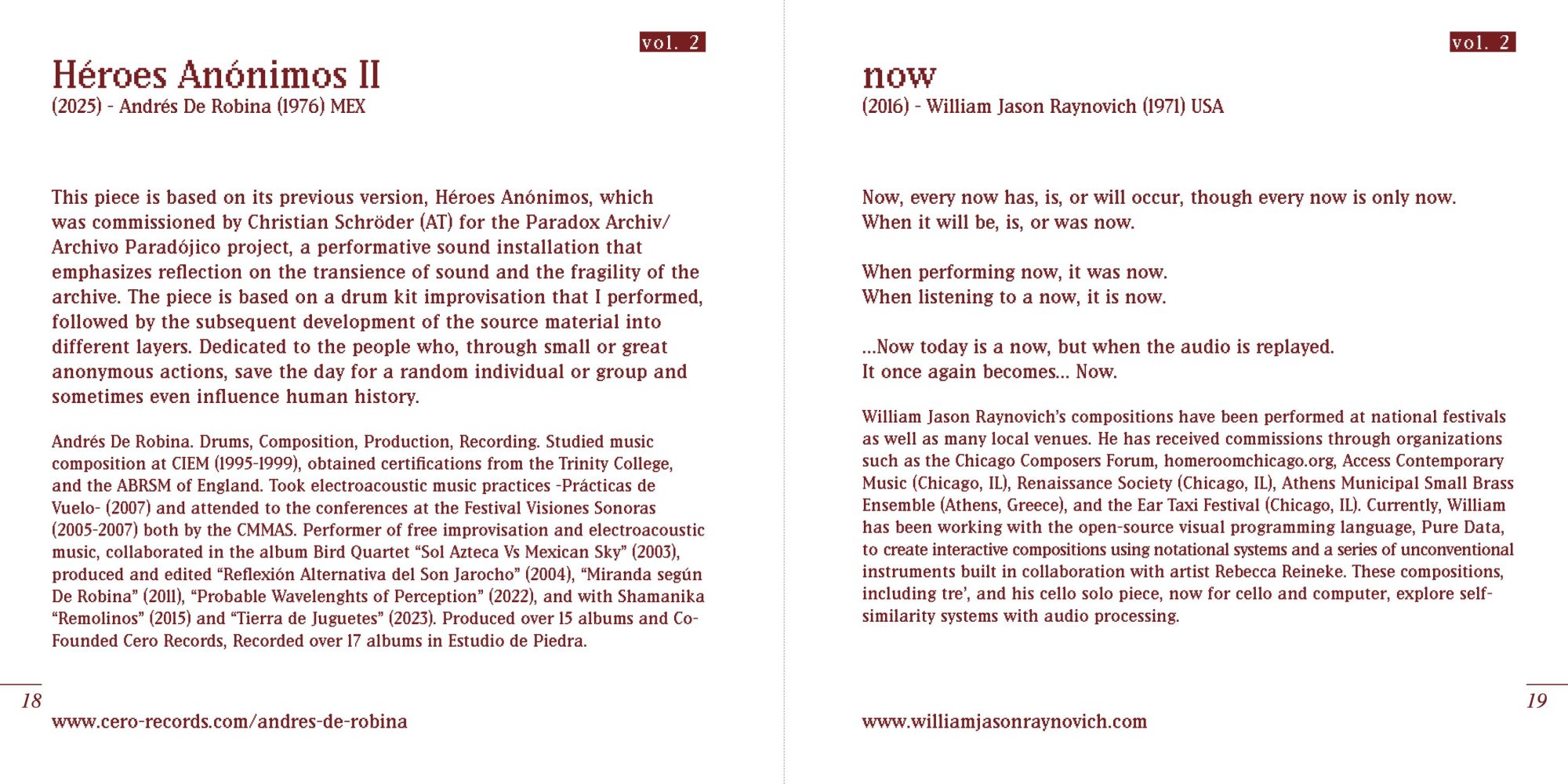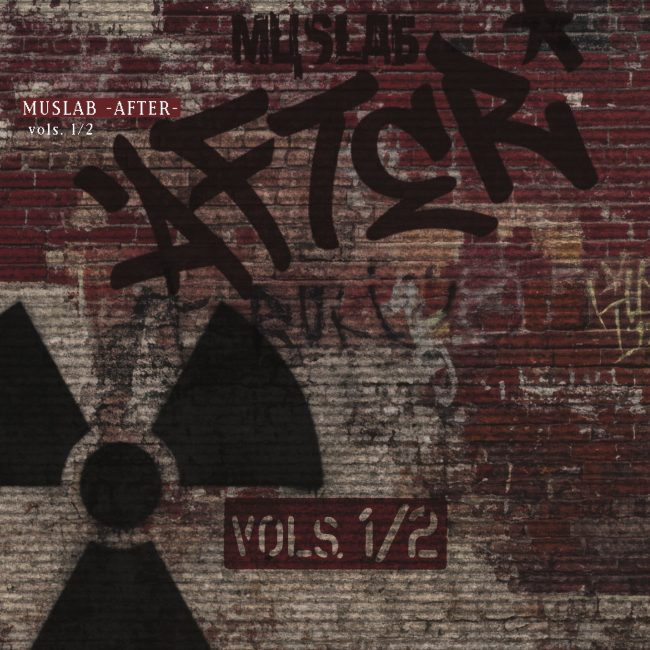Tracking
MUSLAB -AFTER-
Vol.1
1 N’vi’ah – João Pedro Oliveira 10:58
2 Shadow Objects – Chin Ting Chan 5:45
3 Salix – Clemens von Reusner 6:09
4 Matters 8 – Daniel Mayer 8:36
5 What Sleeps Beneath – Kramer Elwell 7:34
6 Post Anthropocene Record No. X.01 – Edmar Soria 10:17
7 Les Pleureuses (The Mourners) – Stéphane Borrel 7:40
8 Feather Hunt – Mat Ward 9:23
9 Creation’s Gap – Simona Dichio 4:06
10 Arecibo – Arthur Gottschalk 7:08
Total 77:36
MUSLAB -AFTER-
Vol.2
1 Towards the Morondanga Galaxy – Mario Mary 10:00
2 Heart of Cain – Kaleb Rhea 6:43
3 La Mer Émeraude – João Pedro Oliveira 10:58
4 Icaro – Álvaro Martín 12:19
5 Alte Freunde – Hans Tutschku 15:10
6 Héroes Anónimos II – Andrés De Robina 7:18
7 now – William Raynovich 14:13
Total 76:41
Compositores / Descripciones de las obras
MUSLAB -AFTER-
Vol.1
N’vi’ah (2019) – Joao Pedro Oliveira (1959) PRT
N’vi’ah is an Old Testament word meaning prophetess.
A prophetess conveys one or more divine messages often in the form of inspired songs and projecting events in the future. And many times her words are cryptic, requiring interpretation or even translation. This work uses isolated phonemes as musical material. Intelligible words are not articulated, leaving to the listener the imagination of what their contents and meanings could be. N’vi’ah was commissioned by the Ibermúsicas Project, and composed at the Human Interaction Laboratory – Diego Portales University in Santiago de Chile. It is dedicated to Federico Schumacher.
Composer João Pedro Oliveira holds the Corwin Endowed Chair in Composition for the University of California. He studied organ performance, composition, and architecture in Lisbon. He completed a Ph.D. in Music at the University of New York at Stony Brook. His music includes opera, orchestral compositions, chamber music, electroacoustic music, and experimental video. He has received over 70 international prizes and awards, including the Guggenheim Fellowship, the Bourges Magisterium Prize, and the Giga-Hertz Special Award. He taught at Aveiro University (Portugal) and Federal University of Minas Gerais (Brazil). His publications include articles and a book on 20th century music theory. www.jpoliveira.com
Shadow Objects (2022) – Chin Ting Chan (1986) HKG
Casting the shadow of a three-dimensional object on a two-dimensional plane transforms its original shape into something that may look distorted, broken, or unrecognizable at times. Yet, it can move in a sporadic and expressive way. The music is inspired by observing this behavior. It helps us realize that we can discover endless beauty in the struggle and imperfection of life. Eventually, we become appreciative of what might seem fragile or faulty on the surface.
Composer Patrick Chin Ting CHAN grew up in Hong Kong and came to the United States in 2003. He has been featured in festivals including Ars Electronica, IRCAM’s ManiFeste, ISCM World Music Days, and UNESCO International Rostrum of Composers, among others. He has worked with ensembles such as City Chamber Orchestra of Hong Kong, Ensemble intercontemporain (France), Ensemble Metamorphosis (Serbia), eighth blackbird (U.S.), Hong Kong New Music Ensemble, Mivos Quartet (U.S.), and New York New Music Ensemble, with performances in more than thirty countries. His scores are published through BabelScores and Universal Edition. www.chintingchan.com
Salix (2020) – Clemens von Reusner (1957) GER
The work “Salix” originates from sonic gestures and textures during an acoustic observation of branches and leaves of a very old specimen of a “Salix Alba Tristis” from the willow family (Salicaceae), which were slightly moved by a rising wind. Formal proportions become clear in the deployment intervals of distinctive sounds according to the golden ratio. Not only this mighty tree, but also all other living creatures in nature and the earth that supports them, need our care and mindful treatment today and in the future more than ever before.
Clemens von Reusner, german composer (* 1957). His works of electroacoustic music and radiophonic audio pieces focus on both purely electronically generated sounds and sounds found in special places and processed in the studio. The work on sound itself, its arrangement and movement on individual tracks in the virtual acoustic spaces of multi-channel loudspeaker configurations are at the centre of his compositional work. He is a member of the “Academy of German Music Authors”. His works have been awarded with national and international prizes, most recently the international Thomas-Seelig-Fixed-Media-Award 2024. They are performed worldwide at renowned festivals for contemporary music. www.cvr-net.de
Matters 8 (2022) – Daniel Mayer (1967) AUT
Sound as mutual matter, it shall determine everything else: constellation and process, they ought to emerge from it, equitable. How do I find what I like? Not at all, as I like what I find and I’m searching without knowing for what. It appears and queries me wordlessly, the talk develops within the experiment, the algorithms of transformation and organization. Matters 8 grew from a simple example of ring modulation with feedback. The gradual algorithmic change of a few parameters causes a morphing between two textures, from noisy and intense to sparkling and fluffy.
Daniel Mayer (*1967) is a composer who focuses on works including electro-acoustics, engaged in sound synthesis and generative computer algorithms. He finished studies in pure mathematics, philosophy, and music composition with Gerd Kühr in Graz, Austria. 2001/02 postgraduate study at the electronic studio of the Music Academy of Basel, Switzerland, with Hanspeter Kyburz. Working at the University of Music and Performing Arts Graz/IEM since 2011. Visiting professor for electro-acoustic composition since 2016. In the winter term 2022/23, he was Edgard-Varèse guest professor of DAAD at TU Berlin. https://daniel-mayer.at
What Sleeps Beneath (2021) – Kramer Elwell (1990) USA
“Long ago, along the Wisconsin shoreline, a mother bear and her two cubs were driven into Lake Michigan by a raging forest fire. The bears swam for many hours, but soon the cubs tired. Mother bear reached the shore first and climbed to the top of a high bluff to watch and wait for her cubs. The cubs drowned within sight of the shore. The Great Spirit created two islands to mark the spot where the cubs disappeared and then created a solitary dune to represent the eternal vigil of mother bear.”
– Anishinaabe creation myth for the Sleeping Bear Dunes
Kramer Elwell (USA) is a composer, sound artist, and researcher currently based in Washington state. His acoustic and electroacoustic works invoke massive, timbre-rich sound spaces, spin cryptic and surrealist narratives, and engage with atypical performance practices. His works are frequently heard internationally and have received honors in competitions such as the Metamorphoses Competition, Destellos, Musica Nova, and Citta’ di Udine. http://kramerelwell.com
Post Anthropocene Record No. X.01 (2023) – Edmar Soria (1983) MEX
In 1950, Alan Turing published “Computing machinery and intelligence” in which he proposed the “imitation game”, to establish a type of heuristic in which it would be possible to know whether or not a machine exhibits intelligent behavior. The article begins: can a machine think?. More than 70 years later, a new question is proposed: Can a machine dream?. This acousmatic work represents (from a speculative point of view) the experiential record of the first machine that was able to dream, some time ahead in a unknown future. And so, this works place us at the first person´s perspective of its first dream.
Researcher of algorithmic composition, 3D music, and technology applied to digital art, data visualization and data/Art. Director of the International Colloquium Space – Immersivity, PhD in music technology, Master in Music Technology, and Master in Economics from the UNAM, Bachelor in Mathematics at the IPN, Professor of Digital Art at the UAM, Head of research area PiATS. Winner of the Acousmonium INA GRM-Fonoteca Nacional 2016 Competition (France-Mexico), SONOM 2014, and finalist of the Concours International de Composition Electroacoustique SIME 2018 (France). His works include multichannel sound art, acousmatic music, mixed music, live electronics, multimedia performance and music for contemporary dance. https://soundcloud.com/edmar-soria
Les Pleureuses (The Mourners) (2003) – Stéphane Borrel (1964) FRA
Les Pleureuses (The Mourners) is an excerpt from an electroacoustic work untitled Laughing Tonalities. It is customary to contrast laughter with crying. On a purely sonic level, however, things seem much less clear-cut. Sometimes we cannot tell by ear whether the person we hear is laughing or sobbing, and to know, we must search in their face. The vocal sounds produced during funeral ceremonies leave no room for doubt. But nerves are sometimes so tried that laughter can arise without us expecting. Moreover, we remember that there still exist (in China, India, in some African countries) professional mourners hired to feign grief during funerals in order to give an augmented impression of importance to the tribute paid to the deceased. These various remarks are provided to suggest possible readings of the piece that mobilizes two, then three, and finally four women’s voices.
Stéphane Borrel lives and works in Lyon, France. He writes for different ensembles and diverse electronics, ranging from chamber music to the symphony orchestra, from mixed music to sound installations or acousmatic pieces, as well as for the performance arts. Since 2003, he teaches composition at Conservatoire de Lyon. www.stephaneborrel.fr
Feather Hunt (2024) – Mat Ward (1969) AUS
Feather Hunt uses an organ drone as the foundation for a series of rhythmic and tonal experiments via layers of acoustic and electronic instruments ( percussion, double bass, modular synths, field recordings and woodwinds). The methodology behind its creation is one of chance and sonic collage: Ward invites people (not just musicians) from across the world, to send audio files which he listens to, manipulates and arranges ‘as suggested by the work’. Both the aesthetic and the compositional methods use what Frank Zappa called Xenocrony – the mixing of separately recorded and rhythmically opposing musical phrases to create polyrhythmic and polytempi compositions.
Mat Ward is a musician and researcher whose practice includes performance, installation, expanded cinema , noise art, sonic portraiture and improvisation. He collaborates extensively across the world. His research examines the acoustic properties of noise and its relationship to human emotion and communication. In 2022 he formed the art collective Then She Reaches For The Gun to explore sonic collage and xenography. The submitted piece Feather Hunt is a result of this project where Ward is manipulated and arranged sounds sent to him from participants across the globe. www.matward.net
Creation’s Gap (2023) – Simona Dichio (2003) ITA
“Creation’s Gap” aims to explore the cycle of life and the mystery of time through the wise eyes of an old oak in the dense forest. The approach of two creatures sparks a play of glances that unleashes a temporal metamorphosis. The tree undergoes a rapid cycle of growth and decline while time seems to stretch around it. The eyes of the brighter animal shine with intense red, marking a turning point. In the end, yet another significant visual encounter leaves the oak unchanged in its eternal cycle of life and rebirth. “Creation’s Gap” invites listeners to reflect on the cyclical nature of life and the timeless flow of time through an immersive sonic experience.
Simona Dichio was born in 2003 in Cerignola (Foggia, Italy). Was introduced to music at seven years old when she starts studying classic guitar. Successively she starts studying also percussion, electric guitar and clarinet. Parallel to classical musical training, finds interesting electroacustic and experimental music composition. She’s graduated from the Music High School “C. Poerio” in Foggia and is actually registered to the second year of the Academic Triennium of 1 Level in Electronic Music at the “U. Giordano” conservatory in Foggia. Currently studying with the master N. Monopoli. simona.dichio22@gmail.com
Arecibo (2011) – Arthur Gottschalk (1952) USA
The Arecibo Observatory was a radio telescope located in Puerto Rico. The observatory’s radio telescope was the largest single-aperture telescope ever constructed. Since 1963 it made radar astronomy observations of solar system objects. The telescope was internationally recognized for its work in the Search for Extraterrestrial Intelligence (SETI). The observatory was damaged by hurricanes and allowed to collapse through neglect by Donald Trump’s administration. This piece, Arecibo, imagines the sounds represented by the radio signals received from the vastness of our universe, and may or may not contain audible clues as to the existence of intelligent life therein. Listen closely…
Arthur Gottschalk is Professor of Music at Rice University. His awards include the 2005 Corciano Prize, a Bogliasco Fellowship, the Charles Ives Prize of the American Academy of Arts and Letters, the 2014 Gold Medal for his Sonata for Cello: In Memoriam, the 2015 Gold Medal and Recording of the Year from the Global Music Awards for his Requiem, Featured Composer for the Thailand International Music Festival, and Featured Composer of the 2019 China-ASEAN Music Festival. Residencies include the Columbia-Princeton Electronic Music Center, the Piccolo Spoleto Festival, the MacDowell Colony, and the American Academy in Rome. He is published and recorded internationally. He teaches Music Business and Law at Rice University, and has worked in the commercial recording field since the 1970s. www.arthurgottschalk.com
MUSLAB -AFTER-
Vol.2
Towards the Morondanga Galaxy (2022) – Mario Mary (1961) FRA
The work is inspired by the idea of a journey to an imaginary galaxy. The electroacoustic sounds suggest the sounds of the spaceship and illustrate the various events it goes through on its journey. Cosmic space and the space of the electroacoustic composition merge in the musical discourse.
He obtained the degrees of Licentiate and Professor of Composition at the National University of La Plata (Argentina) and a PhD in ‘Aesthetics, Sciences and Technology of the Arts’ at the University Paris VIII (France). He is currently Professor of Electroacoustic Composition at the Rainier III Academy in Monaco, and Artistic Director of the International Festival of Electroacoustic Music (FIME), Argentina. Between 2011 and 2019 he directed the ‘Rencontres Internationales de Musique Electroacoustique’ in Monaco. Between 1996 and 2010 he was a professor at the University Paris VIII, where he directed the ‘Cycle de concerts de musique par ordinateurs’. He has worked as a composer-researcher at IRCAM (AudioSculp, cross-synthesis manual). Has won around thirty prizes for instrumental, electroacoustic and mixed composition, and has given around a hundred lectures and courses in different countries in Europe and America. Through his compositions, he has developed a personal technique of electroacoustic orchestration and polyphony of space. http://ipt.univ-paris8.fr/mmary/
Heart of Cain (2023) – Kaleb Rhea (1996) USA
This piece is about Cain’s sacrifice to God from the story of Cain and Abel. We are told that Cain’s heart was corrupted, but we do not know to what degree. This piece depicts Cain’s partially corrupted heart. To show the corruption, I edited the samples to create a spectrum of recognizability. The corrupted sounds range from glitchy to pitch shifted, from muted to completely unrecognizable. The samples were taken from a number of objects like door handles, markers and erasers, the mouth, projector and screen, a wooden desk, a metal water bottle, and keys.
Kaleb Rhea (b.1996) went to Illinois College to develop his voice. Dr. Timothy Kramer personally oversaw his growth and broadened his knowledge. After receiving his Bachelor’s of Arts from Illinois College in May 2018, Kaleb went to study at Western Illinois University. He studied with Pulitzer Prize Finalist Dr. James Romig. He received his Master’s of Music in composition in May 2020. Kaleb is currently working on a D.A. in Music Theory and Composition at Ball State University and teaching composition, music theory, and songwriting at Indiana University East. He also has a YouTube channel, @kalebrhea. http://soundcloud.com/kaleb-rhea
La Mer Émeraude (2018) – Joao Pedro Oliveira (1959) PRT
Let us imagine a small invented world, a micro universe where everything exists… matter, energy, spirit, telluric movements, mysteries, natural and supernatural forces. That world is whole and from afar, whoever watches, sees it as a living ocean. This work was composed in the Musiques-Recherches studio and is dedicated to Annette Vande Gorne and Francis Dhomont. It received the second prize at SIME Competition 2019, the first Prize at Cittá di Udine Competition 2020, the first prize at Destellos Competition 2020 and the first prize at the Chicago Composers Consortium Competition.
Composer João Pedro Oliveira holds the Corwin Endowed Chair in Composition for the University of California. He studied organ performance, composition, and architecture in Lisbon. He completed a Ph.D. in Music at the University of New York at Stony Brook. His music includes opera, orchestral compositions, chamber music, electroacoustic music, and experimental video. He has received over 70 international prizes and awards, including the Guggenheim Fellowship, the Bourges Magisterium Prize, and the Giga-Hertz Special Award. He taught at Aveiro University (Portugal) and Federal University of Minas Gerais (Brazil). His publications include articles and a book on 20th century music theory. www.jpoliveira.com
Icaro (2017) – Álvaro Martín (1989) ESP
“Icaro” explores the paradox of ambition through a sonic journey that parallels the myth of Icarus. Ambition drives progress, yet unchecked ambition can lead to downfall. Metallic and electronic sounds symbolize technological advancement and the allure of reaching new heights. Spatialization techniques immerse listeners in a dynamic environment, echoing the vast expanse of human ambition. As Icarus flew too close to the sun, our pursuit of progress can lead to unforeseen consequences. Through intricate layers of sound, the piece prompts reflection on the delicate balance between aspiration and its potential repercussions.
Alvaro Martin is a composer and sound artist focused on the expression through new media. He graduated in composition at the Conservatorio Superior de Castilla y León where he found a passion for electroacoustic music that pushed him to refine it at the Conservatorio di Parma under Javier Torres Maldonado’s guidance and at the Centro Superior Katarina Gurska with composers Sergio Luque and Alberto Bernal. As an electronic music performer, he collaborates with leading ensembles and festivals, showcasing his versatility and commitment to experimental music. He currently shares his knowledge and passion for music technology and electroacoustic composition at COSCYL. https://soundcloud.com/alvaro-martin-sanchez-276885844
Alte Freunde (2021) – Hans Tutschku (1966) GER
The composition is based on recorded improvisations with the Serge and Buchla analog synthesizers and some layers composed with the VCV virtual Eurorack.My exploration of electronic music started in 1982, using an EMS Synthi E, followed by the EMS AKS and a Minimoog. For about a decade, I only used analog gear before joining computer and synthesizers in the early 1990th. Even though the computer has taken over most of my sound processing and composition tools, I’m revisiting my old friends from time to time.
Hans Tutschku is a composer of instrumental and electroacoustic music. In 1982 he joined the Ensemble für intuitive Musik Weimar. Studied theatre and composition in Berlin, Dresden, The Hague, Paris, and Birmingham. He collaborated in film, theatre, and dance productions, and participated in concert cycles with Karlheinz Stockhausen. Since 2004 he directs the electroacoustic studios at Harvard University. Improvisation with electronics has been a core activity. Winner of international competitions: Hanns Eisler Prize, Bourges, CIMESP São Paulo, Prix Ars Electronica, Prix Noroit, Prix Musica Nova, ZKM Giga-Hertz, CIME ICEM, and Klang!. In 2005 he received the Culture Prize of the City of Weimar. https://tutschku.com/
Héroes Anónimos II (2025) – Andrés De Robina (1976) MEX
This piece is based on its previous version, Héroes Anónimos, which was commissioned by Christian Schröder (AT) for the Paradox Archiv/Archivo Paradójico project, a performative sound installation that emphasizes reflection on the transience of sound and the fragility of the archive. The piece is based on a drum kit improvisation that I performed, followed by the subsequent development of the source material into different layers. Dedicated to the people who, through small or great anonymous actions, save the day for a random individual or group and sometimes even influence human history.
Andrés De Robina. Drums, Composition, Production, Recording. Studied music composition at CIEM (1995-1999), obtained certifications from the Trinity College, and the ABRSM of England. Took electroacoustic music practices -Prácticas de Vuelo- (2007) and attended to the conferences at the Festival Visiones Sonoras (2005-2007) both by the CMMAS. Performer of free improvisation and electroacoustic music, collaborated in the album Bird Quartet “Sol Azteca Vs Mexican Sky” (2003), produced and edited “Reflexión Alternativa del Son Jarocho” (2004), “Miranda según De Robina” (2011), “Probable Wavelenghts of Perception” (2022), and with Shamanika “Remolinos” (2015) and “Tierra de Juguetes” (2023). Produced over 15 albums and Co-Founded Cero Records, Recorded over 17 albums in Estudio de Piedra. www.cero-records.com/andres-de-robina
now (2016) – William Jason Raynovich (1971) USA
Now, every now has, is, or will occur, though every now is only now.
When it will be, is, or was now.
When performing now, it was now.
When listening to a now, it is now.
…Now today is a now, but when the audio is replayed.
It once again becomes… Now.
William Jason Raynovich’s compositions have been performed at national festivals as well as many local venues. He has received commissions through organizations such as the Chicago Composers Forum, homeroomchicago.org, Access Contemporary Music (Chicago, IL), Renaissance Society (Chicago, IL), Athens Municipal Small Brass Ensemble (Athens, Greece), and the Ear Taxi Festival (Chicago, IL). Currently, William has been working with the open-source visual programming language, Pure Data, to create interactive compositions using notational systems and a series of unconventional instruments built in collaboration with artist Rebecca Reineke. These compositions, including tre’, and his cello solo piece, now for cello and computer, explore self-similarity systems with audio processing. www.williamjasonraynovich.com
Créditos
Producción del Fonograma y Masterización: Andrés De Robina – Cero Records
Curaduría: Pedro Castillo Lara – MUSLAB
Diseño Gráfico: Juan Pablo Betancourt
Cero Records. Derechos Reservados. 2025
Libro
Disponible por
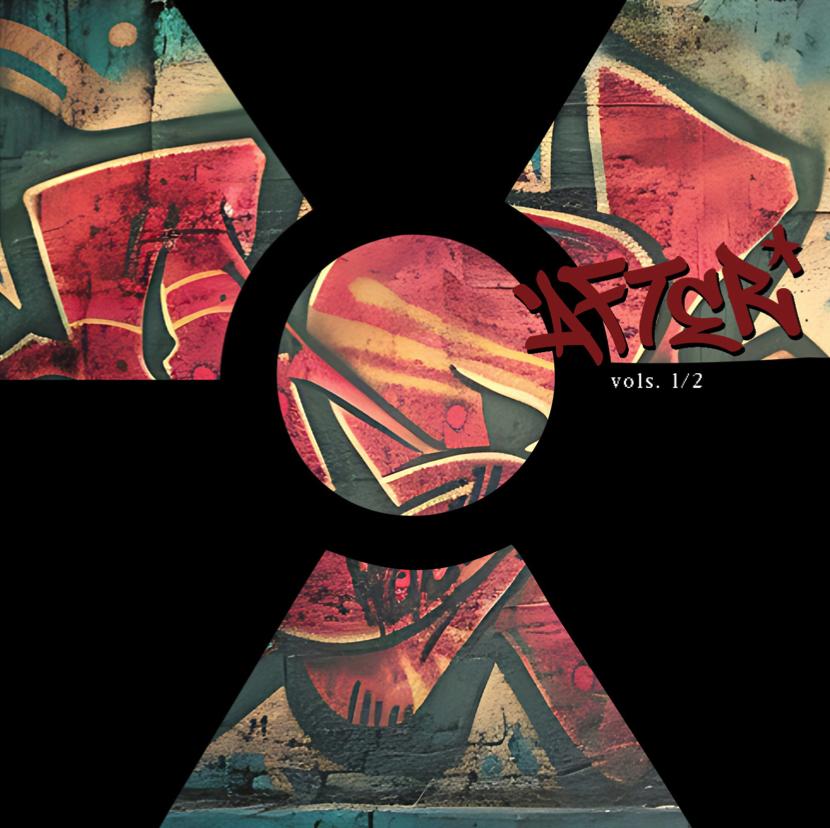
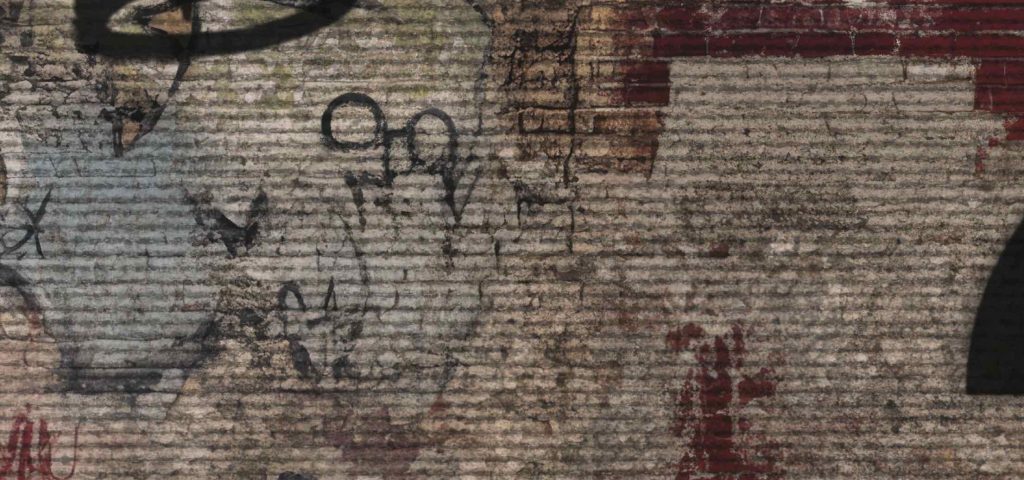
Video
MUSLAB -AFTER- Vols. 1/2
MUSLAB -AFTER-
The Phonographic production MUSLAB -AFTER-, is a selection of sound and audiovisual pieces from the MUSLAB International Electroacoustic Music Exhibition. MUSLAB aims to bring together and disseminate the creation and sound exploration of artists from different countries around the world, promote the creative process and contemporary artistic communication, to bring new audiences closer to contemporary sound creation, and create an international community network through the development of different cultural activities, training in new technologies and sound art concerts.
MUSLAB -AFTER- is an exhibition that brings together works by artists and researchers from different countries who develop sound and visual pieces on visions of the future of the global planetary scenario. Art as an oracle that contemplates the 22nd century and beyond from our contemporaneity. Compositions of electroacoustic music and video art that reflect on society, ecology and different aspects of planet Earth in the future. A proposal to develop new visions, build together a better world and promote more harmonious relationships in society and with nature.
